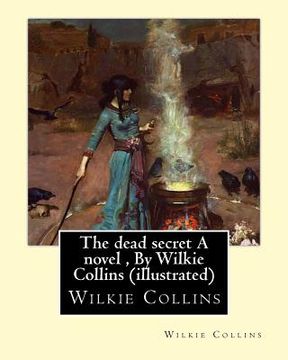Reseña del libro "The dead secret A novel, By Wilkie Collins (illustrated) (en Inglés)"
The Dead Secret was Wilkie Collins' fourth published novel. The secret of the title is the parentage of the heroine, Rosamund Treverton, who has been passed off as the daughter of the wealthy former actress Mrs Treverton of Porthgenna Tower, but is in fact the illegitimate child of her servant Sarah Leeson by a local miner (Mrs Treverton's motive was to provide her husband with a child, being apparently unable to bear children herself). Sarah writes down the details of the secret from the words of the dying Mrs Treverton, and hides the paper bearing the message in an unused room at Porthgenna. The novel then jumps forward some twenty years. Rosamund has married the blind Leonard Frankland, who now owns Porthgenna Tower. Sarah, under an assumed name, obtains a post as servant to the family, and gives Rosamund a cryptic warning to avoid the room in which the Secret is hidden. On a visit to Porthgenna, Rosamund finds the paper detailing the Secret and reveals it to Leonard. Leonard, who was originally deceived into thinking Rosamund was a wealthy heiress, accepts that his wife is illegitimate, but refuses to accept her inheritance. In the course of things, this would now pass to Mrs Treverton's miserly brother Andrew (whose introduction, together with his villainous servant, provides some comic relief in the novel). But Andrew Treverton, somewhat out of character, refuses to accept the windfall and Rosamund remains the heiress of the Trevertons in the expected happy ending. Like its predecessor Hide and Seek, the "secret" and the mystery are made clear to the reader, though not to the novel's characters, at an early stage. The obsessed and arguably deranged Sarah prefigures the character of Hester Dethridge in Collins' Man and Wife, and more distantly those of Lydia Gwilt in Armadale and the female protagonist of his late novel, 'The Haunted Hotel. The blind Leonard is another of Collins' disabled characters. He plays only a small part in the novel, but Collins drew another and more significant blind character in Lucilla, the heroine of his 1872 novel Poor Miss Finch. Much of the novel is set in Cornwall, one of Collins' favourite English counties, which also features in his early melodrama Basil.... William Wilkie Collins (8 January 1824 - 23 September 1889) was an English novelist, playwright, and short story writer. His best-known works are The Woman in White (1859), No Name (1862), Armadale (1866), and The Moonstone (1868). The last is considered the first modern English detective novel. Born into the family of painter William Collins in London, he lived with his family in Italy and France as a child and learned French and Italian. He worked as a clerk for a tea merchant. After his first novel, Antonina, was published in 1850, he met Charles Dickens, who became a close friend, mentor and collaborator. Some of Collins's works were first published in Dickens' journals All the Year Round and Household Words and the two collaborated on drama and fiction. Collins published his best known works in the 1860s, achieved financial stability and an international reputation. During that time he began suffering from gout. After taking opium for the pain, he developed an addiction. During the 1870s and 1880s the quality of his writing declined along with his health. Collins was critical of the institution of marriage and never married; he split his time between Caroline Graves, except for a two-year separation, and his common-law wife Martha Rudd, with whom he had three children.
(Londres 1824-1889) Dramaturgo, novelista y prolífico autor de relatos. A los 17 años comienza a trabajar en una empresa de comercio de té mientras escribe Ioláni, o Tahití tal como era (Gótica nº 32), obra que no vio la luz hasta más de un siglo después de su muerte. Estudió Derecho y, aunque nunca llegó a ejercer, sí utilizó los conocimientos jurídicos en muchas de sus obras, y la crítica le considera uno de los padres del género policiaco. En 1851, conoce a Charles Dickens, al que le unirá una profunda amistad y publicará en su semanario All the Year Around sus principales obras. Tras la muerte de Dickens en 1870, su popularidad decae. Padeció de gota reumática la que le acabó provocando una adicción al opio. El epitafio de su tumba le destaca como el autor de la novela La dama de blanco.
Ver más
Ver menos

